
When contacting us by e-mail, correspondents are asked to include their name and full postal address and, when providing information, to quote exact book and magazine sources. The word ‘chess’ needs to appear in the subject-line or in the message itself.
| First column | << previous | Archives [41] | next >> | Current column |

Mate in two.
‘Dear Dr Watson: Can you solve this?
I played a game and arrived at this position. To my surprise it developed to be a sound two-mover. (This is a clue.)’
The above note was written by a US composer. Watson believed that he had found the solution, only to be contradicted by Sherlock Holmes.
We shall revert to the matter shortly.
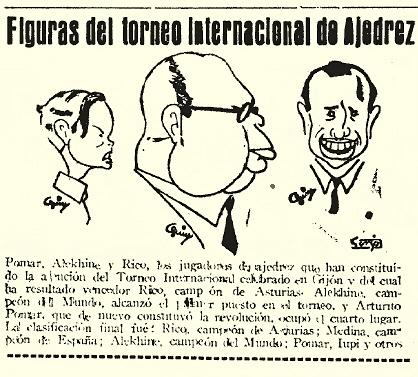
Christian Sánchez (Rosario, Argentina) sends the above cutting with caricatures of Arturo Pomar, Alexander Alekhine and Antonio Rico at Gijón, 1945, from page 6 of the Spanish (Cuenca) newspaper Ofensiva of 2 August 1945.
The caricature of Alekhine must be one of the last published during his lifetime.
Page 397 of Kings, Commoners and Knaves noted the following anonymous quote in the American Chess Bulletin, June 1907, page 119, taken from the Johannesburg Sunday Times:
‘Hindsight is the most precious gift ever vouchsafed to chess players. Next to that is the foresight of the spectator. Then follows the keenness of vision of the annotator.’
We now find that the remark had been cited, also anonymously, on page 81 of Lasker’s Chess Magazine, December 1904.
Tomasz Lissowski (Warsaw) submits the following game, from the Polish publication Sport, 1900, page 23:
Alexander Flamberg – Szymon Winawer1 e4 d6 2 d4 Nf6 3 Nc3 Bg4 4 f3 Be6 5 Nge2 Bf7 6 Be3 c6 7 Qd2 Nbd7 8 O-O-O Qa5 9 Kb1 b5 10 Nd5 Qd8 11 Nxf6+ exf6 12 g4 a5 13 f4 Nb6 14 Ng3 d5 15 e5 Nc4 16 Bxc4 dxc4 17 f5 Bd5 18 Rhf1 Be7 19 Nh5 O-O 20 Nf4 b4 21 Nxd5 cxd5 22 h4 a4 23 g5
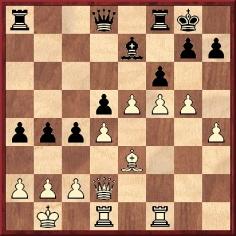
23...b3 24 gxf6 a3 25 fxe7 bxa2+ 26 Ka1 axb2+ 27 Kxb2 Qb6+ 28 Ka1 Qb1+ 29 Rxb1 axb1(Q)+ 30 Kxb1 Rfb8+ 31 Qb4 Rxb4+ 32 Kc1 c3 33 Kd1 Rb1+ 34 Ke2 Rxf1 35 Kxf1 Kf7 36 Ke2 Kxe7 37 Kd3
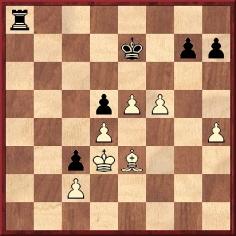
37...Rf8 38 Bg5+ Kd7 39 f6 gxf6 40 Bxf6 Rc8 41 Bg5 Ke6 42 Bf6
Kf5 43 Bg5 Rc6 44 Bf6 h6 45 Be7 Kf4 46 Bf8 Kf5 47 Bd6 Rc8 48 Bc5
Ke6 49 Kxc3 Rg8 50 Bb6 Rg3+ 51 Kb4 Rg4 52 Bd8 Rxd4+ 53 Kc3 Rd1
54 Bf6 Kf5 55 Kb3 Ke6 56 Kc3 h5 57 Kb3 Rh1 58 Kc3 Rh3+ 59 Kd2 d4
60 Ke2 Kd5 61 Kd2 Re3 62 Bg7 Kc4 63 Bh8 Rf3 64 Bf6 Rf2+ 65 Kd1
Kc3 66 Bg5 Rf1+ 67 Ke2 Rf5 68 Kd1 Rxe5 69 Bd2+ Kc4 70 Be1 Re4 71
Kd2 Rg4 72 Kd1 Rg1 73 Ke2 Rg2+ 74 Kd1 d3 75 White resigns.
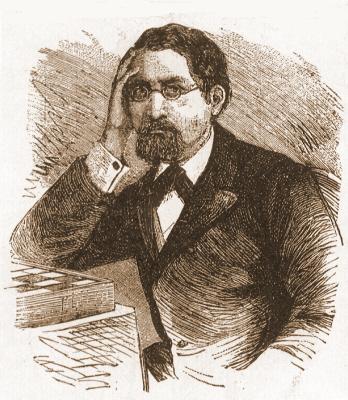
Szymon Winawer
One of the most celebrated double blunders in chess history occurred in the game between Capablanca and Sir George Thomas in Hastings on 14 August 1919.
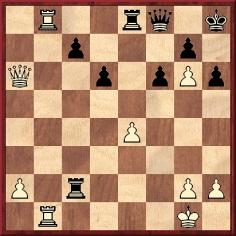
The game ended 29 Qa8 Resigns, but Capablanca could have won a rook with 29 Rxe8 Qxe8 30 Qa4. Instead of resigning, Black could have drawn with 29...Rxa2.
The mistakes were immediately noted at the time. In The Field Amos Burn called 29 Qa8, ‘a remarkable oversight’, adding, ‘And it was perhaps still more remarkable that Sir George Thomas, thinking he had a lost game, should have resigned without examining the position’. Burn’s notes were given when the game was discussed on pages 206-207 of the September-October 1919 American Chess Bulletin. The magazine described the game as ‘one of the most curious in the annals of chess play’.
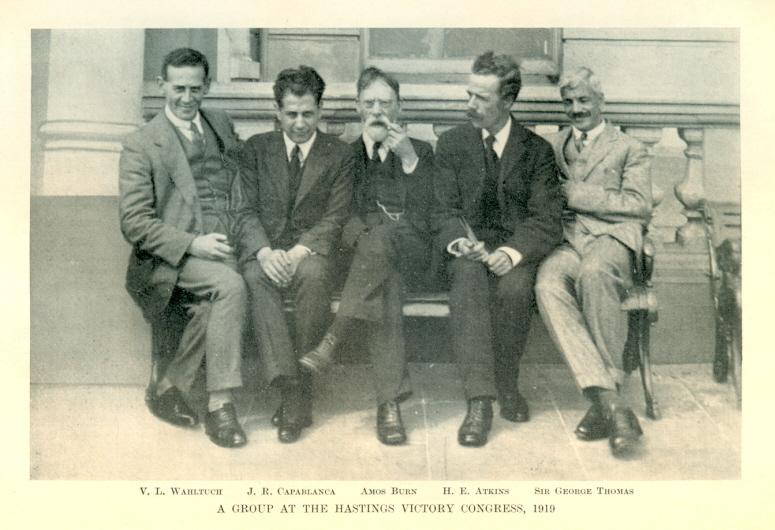
From A Century of British Chess by P.W. Sergeant (London, 1934)
Brian Harley related the Capablanca v Thomas incident on pages 11-12 of his book Chess and its Stars (Leeds, 1936):
‘Capablanca played Q-R8, and Thomas forthwith resigned, seeing no reply to the threat, RxR. Thereupon Capablanca walked out of the room, and a hubbub arose. A spectator had found something. Thomas could have carried on with RxRP, meeting RxR by RxQ, or QxR by RxR. A draw would be the legitimate result of either variation. Further and greater hubbub. Spectator No. 2 pointed out that Capablanca could have won offhand, in the position shown above [our diagram] by RxR, forcing the reply QxR, and then Q-R4. This move attacks both queen and rook, and must win a rook. QxQ allows R-Kt8 mate [sic]; if R-B8ch, simply K-B2, when Black is no better off. I had the temerity to indicate this series of accidents to Capablanca as he walked back into the hall, receiving in return a specimen of the look that I have described at the beginning of the chapter.’ [From page 1: ‘He pinches the tip of his aquiline nose in a musing way – a sign of puzzlement that he carried to his manhood.’]
On page 21 of Cabbage Heads and Chess Kings (London, 1960) Bruce Hayden wrote:
‘Among the most illustrious kibitzers of history is the great Joseph Henry Blackburne.
It was he who was responsible for demolishing Capablanca’s play in his famous ending against Thomas in the Hastings Victory Tournament of 1919. I have this on the authority of E.G. Sergeant, the veteran English player, who was present.’
The Times, 15 August 1919, page 13, stated that the on-site analysts included not only Blackburne but also H.E. Atkins, A. Burn and R.C. Griffith, and that Capablanca’s own reaction was as follows:
‘I am not one of those foolish people who make excuses for everything; it was a complete oversight.’
On pages 39-40 of Chess and its Stars (Leeds, 1936) Brian Harley published an open letter to Alekhine:
‘Dear Master,
The chess world undergoes agonies in its struggles with the spelling of your name, which has as many versions as Shakespeare’s.
Twenty years ago you were “Aljekhin”; then you suffered a “c” change to “Aljechin”; and then again we met with “Alechin”. We thought you had attained, with your French citizenship, the ultimate stage with “Alekhine”. And now, in an article in a chess magazine, you sign yourself “Alekhin”.
I recall that I was once asked at a Congress to point out Alkaline, when I made the comment that the acid test of a chessplayer should be the knowledge of the correct spelling of a champion’s name. So I implore you, Master, to make an announcement of a final, fixed and unalterable version: and to stick to it.
Brian Harley.’

Brian Harley
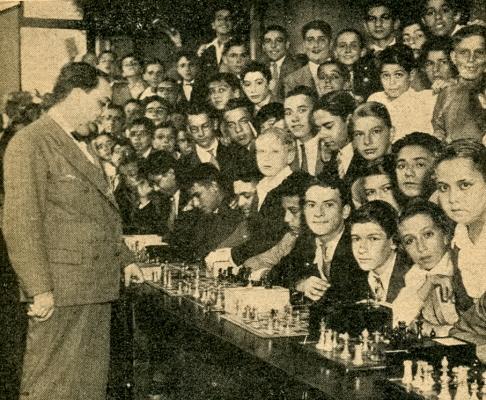
Who is the master in this photograph?
C.N. 67 (see pages 29-30 of Chess Explorations) published ‘a rollicking game’ from page 295 of The Year-Book of Chess, 1914 edited by M.W. Stevens (London, 1915). The details given regarding the occasion were incomplete but are now supplied in the heading below.
P.A.M. MacMahon (Oxford University) – Jacob Schumer1 e4 e5 2 d4 exd4 3 c3 d5 4 exd5 Qxd5 5 Nf3 Bg4 6 Qa4+ Nd7 7 Nxd4 Ngf6 8 Be3 Bd6 9 Nd2 O-O 10 f3 Nc5 11 Qc2 Rfe8 12 Kf2 Rxe3 13 Kxe3 Re8+ 14 Kf2 Qe5 15 Nc4 Qf4 16 g3
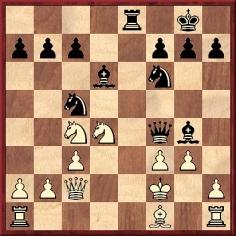
16...Nce4+ 17 Kg2 Nxg3 18 Nxd6 Re3 19 fxg4 Nxg4
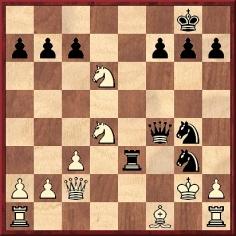
20 Qxh7+ Kf8 21 Qh8+ Ke7 22 Qe8+ Kxd6 23 Nf5+ Nxf5 24 Rd1+ Rd3 25 Rxd3+ Kc5 26 b4+ Kb6
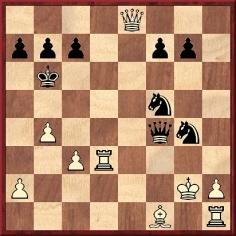
27 Qb5+ Kxb5 28 Rf3+ Resigns.
The game-score was published on page 57 of the April 1914 Časopis Českých Šachistů and on page 260 of the June 1914 Chess Amateur, as well as on pages 286-287 of the July 1914 issue. The date of the match has been gleaned from page 151 of the April 1914 BCM.
Thomas Niessen (Aachen, Germany) asks whether records exist of simultaneous exhibitions in which all the games began with a thematic position.
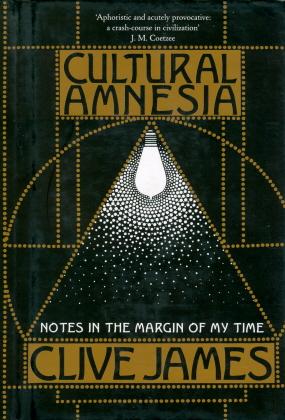
Page 264 of Cultural Amnesia by Clive James (London, 2007) discusses, with examples, the prose style of Edward Gibbon’s The Decline and Fall of the Roman Empire:
‘His aim might have been compression and economy, but the compression was a contortion and the economy was false. In a single sentence, two separated adjectival constructions often served the one noun, or two separated verbs the one object, or two separated adverbs the one verb, and so on through the whole range of parts of speech: it was a kind of compulsive chess move in which a knight was always positioned to govern two pieces, except that the two pieces governed it.’
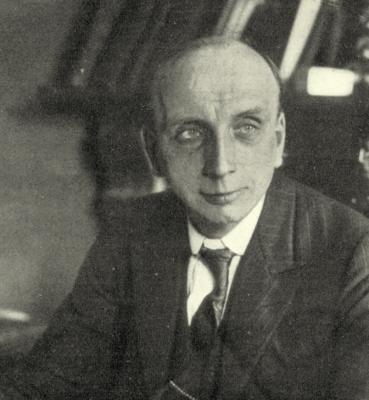
W.H. Watts
The following article by the ‘Badmaster’ originally appeared in Newsflash, October 1983 and was given on page 103 of our publication Chess Characters by G.H. Diggle (Geneva, 1984):
‘W.H. Watts (died 1941), whose Company (Printing-Craft Ltd.) produced so many great chess works, had the advantage over other chess publishers of being a fine player himself. Dr Lasker (a personal friend) consigned to him for publication his famous Chess Manual – other outstanding books printed and edited by Watts were London, 1922 and Nottingham, 1936 with their splendid pictorial Chess Pies, Alekhine v Bogoljubow 1934 and Morphy Gleanings by Sergeant. On top of this he produced and edited for two years (1924-26) a paperback periodical which might be called the forerunner of Newsflash. It was named the Chess Budget and came out weekly (monthly in the summer) with the full scores of all London League and County Matches, together with “the latest news, games, and occasional articles” – post-free for 1½d. The Budget was an entirely “one man band”, Watts being (in his own words) “proprietor, editor, printer, proofreader, manager, publisher, accountant and errand boy”. He might have added that he was also his own “Badmaster” as the “occasional articles” often contained his reminiscences, which went back to Hastings, 1895, where he saw Pillsbury, Steinitz, Bird, Chigorin, etc. in action. But even at the Budget’s “exorbitant” price Watts was finally forced to close it down by a penurious public. One letter from a “supporter” read: “I am not renewing my subscription as I can now see the Chess Budget at my Club. Wishing the Budget every success, etc.”
In spite of all this, Watts found time for a great deal of chess, playing top board for the Athenaeum and on a high board both for Hampstead and for Middlesex, besides frequently competing in Major Opens and Premier Reserves, and once in the British Championship (Tenby, 1928). He even managed to take part in provincial chess (he had Lincolnshire connections) and on occasional weekends, having probably played in a London League Match the evening before, and sat up half the night correcting proofs, he would come tearing down the Great North Road on his rickety old motorbike and take top board for Lincs v Notts. Even after the match, he would neither go home himself nor let anyone else depart: “Let’s have a game of Kriegspiel – What? You don’t play it? – Then you must learn at once, you yokels.” Finally he would go palpitating back in the small hours to his bachelor home in Highgate.
During the 1930s Depression the BM was interested in establishing chess in a provincial club just formed for the unemployed, and he deferentially asked Watts (always affable to young players) to come down from town and give a simul, subject as usual to his famous motorbike being on form and delivering him on the spot in time. The BM (who fancied himself as a Master of Ceremonies) prepared with youthful pomposity a “Red Carpet” oration welcoming “the celebrated London player”. But though the Club barrel had been scraped to the tune of 16 boards “all present and correct” at the appointed hour, the “grandmaster” had not arrived, and the distraught M.C. narrowly escaped “the slow handclap”. Presently, however, the screech of overworked brakes was heard and the “celebrated London player”, in very un-grandmaster style, lurched into the arena all gauntlets and goggles, tore off these impedimenta with all haste, exclaimed “So sorry about this, gentlemen”, and (before “Mark Antony” could even clear his throat) dashed round the circle with P-K4 on each board.’
In the passage below, originally published in the May 1982 Newsflash, G.H. Diggle describes a simultaneous exhibition by Anatoly Karpov at Westergate School, England on 13 April 1982. For the full article, see page 82 of Chess Characters (Geneva, 1984).
‘The world champion in action is probably the quietest and most impassive since Morphy. He presents a huge contrast to Alekhine, who would “launch a foaming tide of White pieces” against 25 victims, striding from board to board as though he had “a tiger in his tank”, and pawing the ground impatiently to get at fresh prey. Anatoly Karpov, “lithe rather than muscular”, wanders delicately around the boards and daintily moves the pieces as though arranging flowers (where possible, he always slides a piece rather than lifts it). At the end of the first three hours (sadly, the BM had to miss the rest) all 25 boards were still in action without a result. The champion, as fresh and imperturbable as at the start, gave no facial indication as to how he thought matters were going, but remained sphinxlike “in trouble and in joy”. He had one occasional mannerism – on pausing at a board he would thrust his left forearm across his front and press his left hand under his right armpit, a slightly Napoleonic touch. In one respect (the BM was informed) he broke with “simul” tradition. The BM (to his own vainglorious delight) had been accorded a seat in the Press Gallery (i.e. the front row) and found himself sitting next to an old comrade in arms, T.W. Sweby of the Luton News. For a brief space they were joined by the BCM Games Editor [William Hartston], who gazed at the world champion’s perambulations as though slightly mystified, and then assumed a grave expression. Perceiving that he was about to give sotto voce utterance, T.W.S. and the BM eagerly craned their necks so as not to miss one word of “IM” wisdom. “Do you realize”, whispered W.R.H., “he’s rotating anti-clockwise.”’
Javier Asturiano Molina (Murcia, Spain) writes:
‘In chess sources there are many spellings of the surname of the player F.P. Bohatirchuk, such as Bohatyrchuk, Bogatyrchuk, Bogatirchouk, Bogatirchuk, Bogatyrtschuk and Bohatyrczuk. A strange addition to the list from recent Spanish magazines is Bogarichuk. How should his name be written?’
It may be recalled that he spent the latter part of his life in Canada, and we should welcome information on which way(s) he wrote his name in English-language sources. Pro memoria, the Russian spelling is Богатырчук.
This Nice, 1930 group photograph was published on page 68 of the April 1930 American Chess Bulletin:
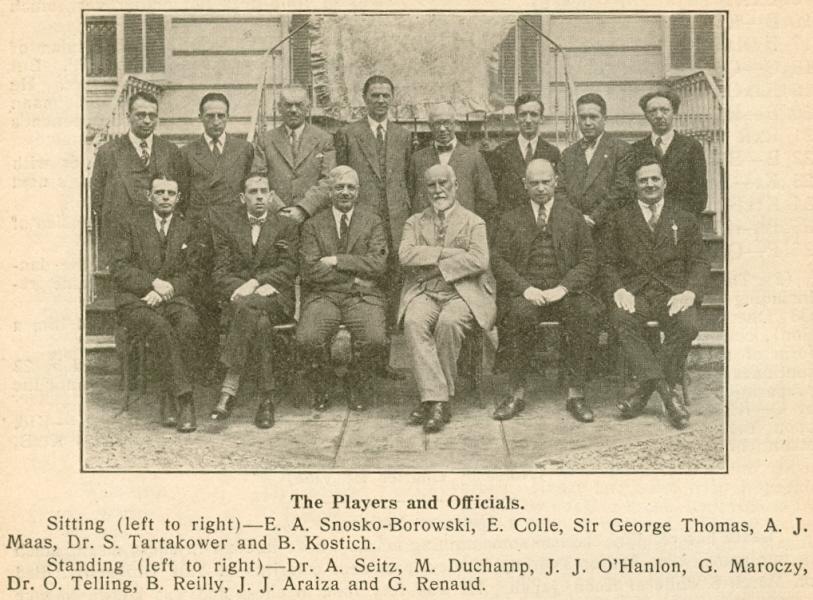
From page 70 of the Dictionary of Modern Chess by Byrne J. Horton (New York, 1959):
‘When Janowsky was asked how far he saw ahead, he replied: “Only one move – the best move.”’
On what basis was the famous rejoinder attributed to Janowsky?
Wojtek Bartelski (Warsaw) writes:
‘I have a seemingly easy question: where and when was the first over-the-board team-match played? (National, club and city events are counted.)’
From Alan O’Brien (Mitcham, England):
‘I have been reading The Oxford Dictionary of Nursery Rhymes by Iona and Peter Opie (copyrighted 1951, but my edition is dated 1992). Pages 404-405 discuss the possibility that the rhyme “Tinker, Tailor, Soldier, Sailor, Rich man, Poor man, Beggarman, Thief” has a connection with the chess pawns:
“There are many variations, the ending ‘Gentleman, apothecary, ploughboy, thief’ being noted several times. Professor Skeat has pointed out that in Caxton’s The Game and Playe of the Chesse (c. 1475) each pawn is shown to have an individuality of its own. ‘The pawns were the Labourer, Smith, Clerk (or Notary), Merchant, Physician, Taverner, Guard and Ribald’, so the rhyme enumerates the eight conditions. ‘The thief is the Ribald; the ploughboy, the Labourer; the apothecary, the Physician; the soldier, the Guard; the tailor, the Merchant; the tinker, the Smith. Only two are changed.’ ([Notes and Queries], 1943).”’
C.N. 3164 (see page 119 of Chess Facts and Fables) discussed David DeLucia’s Chess Library. A Few Old Friends (Darien, 2003) – ‘a new book so stunning in terms of both production and content that we can only marvel at it’. Richly illustrated, it presented the highlights of Mr DeLucia’s vast collection of rare chess books, manuscripts, letters, photographs, equipment, etc., but now he has brought out a second edition which is even larger and better, in a limited edition of 225 copies.
The Foreword (page v) mentions that his most significant acquisition in recent years has probably been a collection of ‘over 100 Lasker manuscripts, 900+ letters, 75+ postcards, numerous signed books, honorary diplomas presented to Lasker as well as many other fine Lasker items’. He has also procured ‘the last remnants of the Capablanca estate which included many of his personal belongings like his alligator wallet, attaché case, top hat with leather carrying case, hundreds of letters written to him in the later years of his life as well as a number of unrecorded games including the one he played against Tartakower’. That last game-score (see pages 180-181 of Kings, Commoners and Knaves) is not included.
The book is a 394-page hardback of incomparable quality, and Mr DeLucia informs us that some copies remain available, at $325. We shall be glad to forward to him any orders or enquiries from C.N. readers.

This is Roberto Grau (1900-44), in a photograph culled from page 142 of the May 1932 issue of El Ajedrez Americano.

Mate in two
This composition was featured in an article ‘Dr Watson Solves a Problem’ by P.G. Keeney on page 8 of the January 1945 issue of the Chess Correspondent. Almost impossible to summarize, it is given here in full.

For a larger version, click here.
A further Sherlock Holmes article, ‘The Adventure of the Strange Sound’ by Alain C. White, was published on pages 229-230 of the May 1914 Chess Amateur, and was based on this problem by Murray Marble:
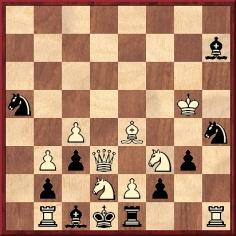
Mate in two
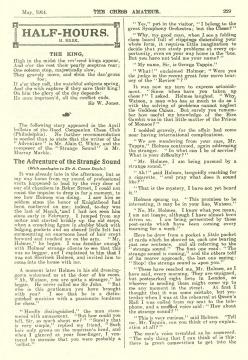

Click here for larger versions of page 229 and page 230.
The solution to this White/Marble item will be given shortly, but already now we mention that it is not as obvious as it may seem.
Pascal Losekoot (Soest, the Netherlands) has found the following news report in the evening edition of Het Vaderland, 9 December 1935, page A:
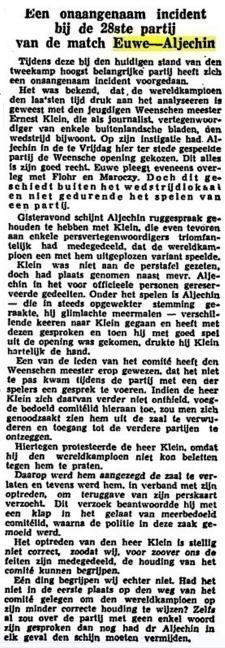
Our correspondent’s English translation is given below:
‘An unpleasant incident during the 28th game of the Euwe-Alekhine match
During this very important (given the current situation of the match) game an unpleasant incident occurred.
It is known that the world champion has been analysing lately with the young Viennese master Ernest Klein, who is representing several foreign papers as a journalist and is therefore attending the match. In Friday’s game in this city [The Hague – the 27th match-game] Alekhine played, at Klein’s instigation, the Vienna Opening. This he is fully entitled to do. Euwe consults with Flohr and Maróczy. However, that happens outside the playing-room and not while a game is being played.
It seems that yesterday evening Alekhine consulted with Klein, who had just previously told other press representatives that the world champion was playing a variation analysed with him.
Klein was not sitting at the press-table; he had taken his seat in the area reserved for officials. During play, Alekhine, who became more and more excited – he smiled several times – went to Klein on more than one occasion and talked to him, and when he had entered the middle-game with a good position he shook hands warmly with Klein.
One of the Committee members pointed out to the Viennese master that it is improper to talk to a player during the game. If Klein would not stop doing so, the Committee member added, the Committee would have no option but to expel him from the playing-hall and forbid him access to the other games.
Klein protested that he could not stop the world champion talking to him.
As a result, he was told to leave the room and to hand in his press-card. This request he answered by slapping the official’s face, after which the police became involved.
Mr Klein’s conduct is clearly not correct, so we can – as far as we are able to judge from the facts – understand the Committee’s reaction.
However, there is one matter that we do not understand. Should not the Committee have first informed the world champion of his incorrect behaviour? Even if not a word was spoken about the game, Dr Alekhine should have prevented anyone from thinking otherwise.’
Dominique Thimognier (St Cyr sur Loire, France) submits pages 20-21 of the Bulletin de la Fédération Française des Echecs, 15 April 1929:
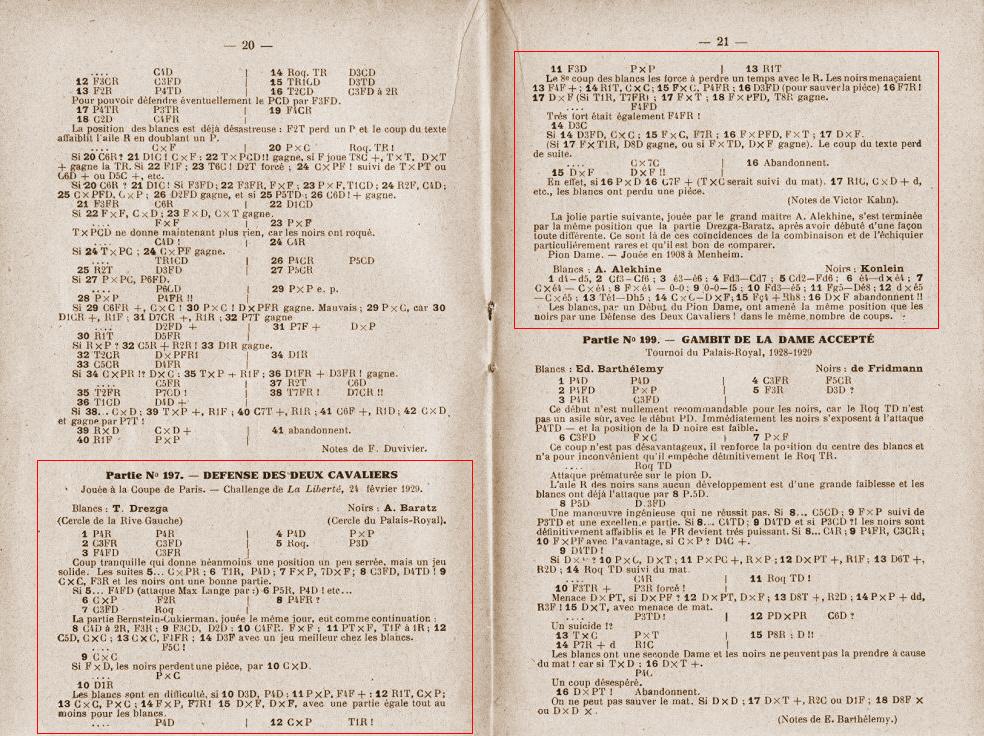

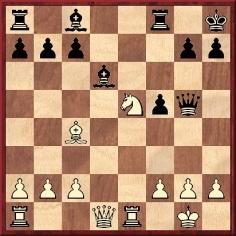
Left: Baratz (in 1929) played 15...Qxd3. Right: Alekhine (in 1908) played 16 Qxd6.
It will be noted that as the venue of the Alekhine game the Bulletin gave ‘Menheim’, which is a Bjelica-style misspelling for Düsseldorf.
We add a few further remarks. The Bulletin provided a precise date for the Drezga v Baratz game, 24 February 1929, and on pages 114-115 of the March 1929 L’Echiquier it was indicated that after Baratz’s victory the coincidence was pointed out by Alekhine.
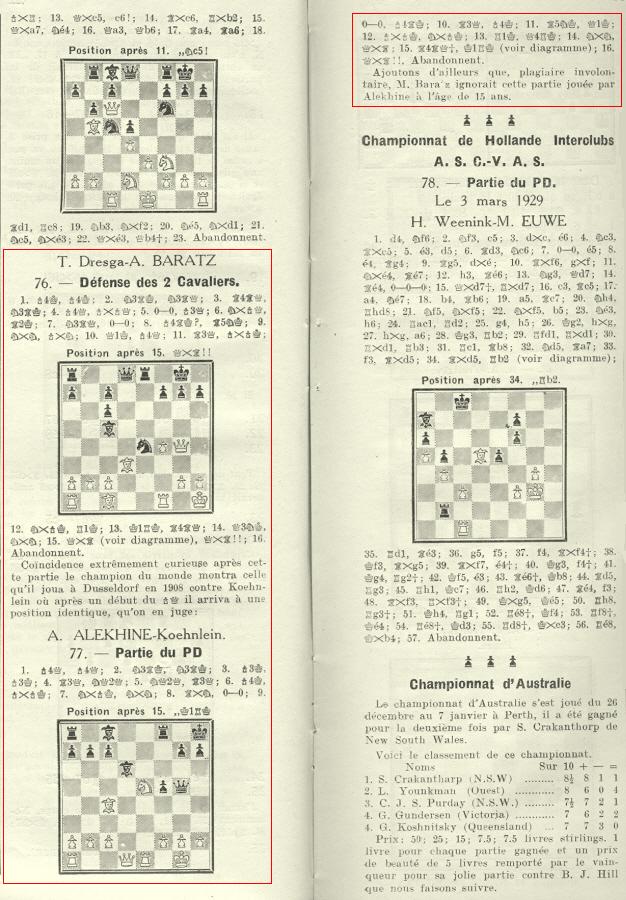
The two games are often discussed jointly (see, for instance, 666 Kurzpartien by Kurt Richter and 1000 Best Short Games of Chess by Irving Chernev). We should welcome examples of similar coincidences.
Alekhine’s victory came in round four of the Hauptturnier A in Düsseldorf on 6 August 1908 and was given on pages 137-138 of the tournament book and on pages 11-12 of the January 1909 Deutsche Schachzeitung. Alekhine was aged 15 at the time of the game. After 16 Qxd6 the anti-climactic finish (not included in the above French-language magazines) was 16...Qxg2+ 17 Kxg2 Resigns. For Köhnlein (1879-1916) it was the only loss in the 14-man event, which he won. He was also known as a composer, and a collection of his best productions in both fields is Friedrich Köhnlein Schachmeister und Problemkomponist by Walter Fentze (Nuremberg, 1984).
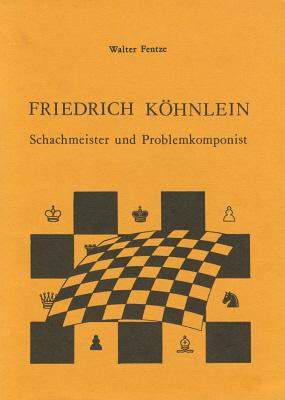
Our collection includes a bound volume of the Deutsches Wochenschach, 1904 inscribed by Köhnlein:
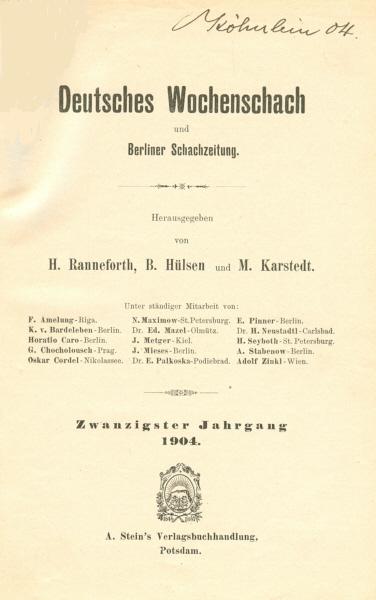
A label explains the volume’s provenance:

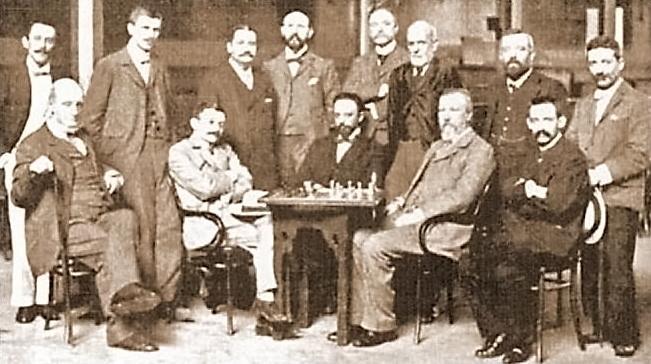
Pierre Bourget (Quebec, Canada) draws attention to this group photograph from London, 1899 which appeared in the ‘Chess is Chess’ CD. Is the source known? Can a version of better quality be found? Readers are also invited to identify the full line-up.

Mate in two
There may, at first sight, appear simply to be a pair of mates in two moves: 1 Kf6 and 1 e3. However, Michael McDowell (Westcliff-on-sea, England) writes:
‘The solution to Marble’s problem is 1 Kf6 f1(white N) 2 Ne3, 1...f1(white Q or B) 2 Qc2 (or, alternatively, 2 Qxe1 in the former case), or 1...f1(white R) 2 Rxe1. 1 e3 fails to 1...f1(white N) because the mating square is now blocked.
The story was reprinted on pages 28-31 of Flights of Fancy in the Chess World by A.C. White (Leeds, 1919), with the solution on page 143. Acknowledgement for research information: the Library of the British Chess Problem Society.’
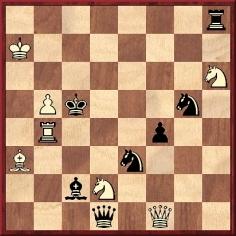
Mate in four
Mr McDowell asks whether the above problem is the only known composition by Ignatz Kolisch. It was published on page 160 of La Régence, May 1860.
From page 201 of the Chess Monthly, March 1891:
‘For 12 months past I have been engaged in the early hours making a complete analysis, with comparative sections, of the Bible, both Old and New Testaments, and my interest in the task, which has been a mighty one, has increased as I have gone on, and in a month or two I hope to be able to publish.’
We have found no trace of such a treatise appearing in print.

Henry Edward Bird
On page 48 of The Knights and Kings of Chess (London, 1894) G.A. MacDonnell wrote of Bird:
‘Fortunately, he bethought him of the Bible, and naturally became intensely interested in the question of figures, as set forth in the Books of the Kings and Chronicles. Then the prophecies of Isaiah attracted his attention, and filled him with delight. They awoke the spiritual in his soul, and caused him to exclaim, “How magnificent”.’
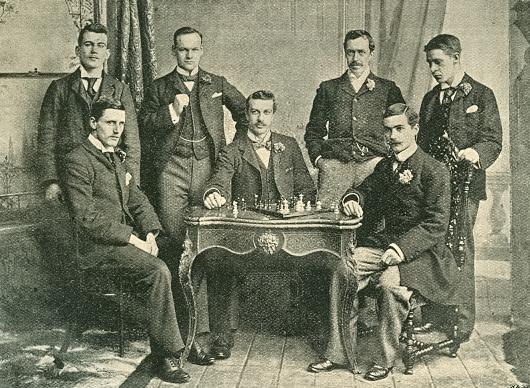
Charles Sullivan (Davis, CA, USA) refers to two positions from games in Alexander Alekhine’s Chess Games, 1902-1946 by Leonard M. Skinner and Robert G.P. Verhoeven (Jefferson, 1998):
a) Alekhine v Turover, Bradley Beach, 3 June 1929 (pages 359-360):
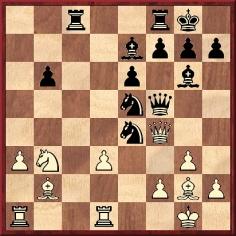
Play is said to have continued 21 Qxe5 Qxe5, and our correspondent asks if both players overlooked 21...Qxf2+, which wins for Black.
The book gave two sources for this game: the Brooklyn Daily Eagle, 13 June 1929, page 32, and the American Chess Bulletin, July-August 1929, pages 130-131. We do not have the newspaper, but according to the game-score in the Bulletin Black’s queen stood at h5, not f5 (18...Qa5-h5).
b) Sämisch v Alekhine, Prague, 15 December 1942 (page 696):
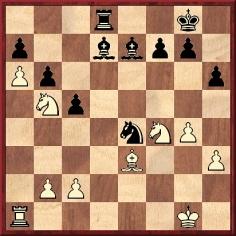
The continuation is given in the book as 26 Nxa7 Bg5, and Mr Sullivan asks if both players really missed 26...Ra8, which wins the knight.
Here, the source specified by Skinner and Verhoeven was page 51 of the Lachaga booklet Prag, 1942 (Martínez, 1973). We have checked the score in another book (also listed in the bibliography, on page 790): Durasův turnaj – Praha 1942 by Karel Průcha (Prague, 1943). It too had the same sequence (1 e4 e5 2 Nf3 d6 3 d4 Nd7 4 Bc4 c6 5 a4 h6 6 Nc3 Be7 7 O-O Ngf6 8 Qe2 Qc7 9 Rd1 Nf8 10 dxe5 dxe5 11 Ne1 Ne6 12 Bxe6 Bxe6 13 Nd3 O-O 14 Be3 b6 15 h3 c5 16 f4 exf4 17 Nxf4 Qe5 18 Nd3 Qh5 19 Qxh5 Nxh5 20 g4 Nf6 21 Nf4 Rad8 22 Rxd8 Rxd8 23 a5 Bc8 24 Nb5 Nxe4 25 a6 Bd7 26 Nxa7 Bg5). Before concluding that there was indeed a double blunder by Sämisch and Alekhine, we should like to know what moves were given in any other publications of the time. The game (drawn at move 41) is absent from the various Czech and German sources currently available to us.
Page 251 of David DeLucia’s new book (see C.N. 5323) mentions that he acquired from Capablanca’s estate a copy of the mystery novel Death Took a Publisher by Norman Forrest. On the inside cover the Cuban’s widow, Olga, wrote that it was the last book he read. The front cover of our copy of the 128-page paperback is reproduced below:
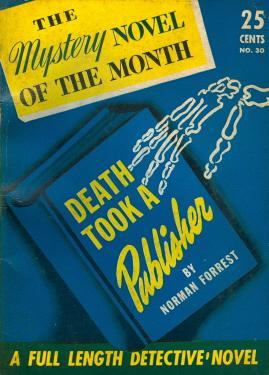

Richard Réti
Further to the discussion in C.N.s 4834 and 4856 on whether Réti was Jewish, Hans-Georg Kleinhenz (Munich, Germany) points out a webpage devoted to Jewish studies, Compact Memory. He comments:
‘Réti had a chess column in the magazine Menorah (subtitled “Illustrated Monthly for the Jewish Home”) from February 1924 to May 1928. The July 1929 issue (page 433) featured an obituary of Réti which mentioned his honorary membership of the Chess Section of the Vienna Hakoah (a Viennese athletic club known for its Jewish football team).
It is interesting to note that his brother Rudolf (or Rudolph) had a column on music in the same publication (January 1924-September 1929).
The whole magazine is available on-line at Compact Memory. For example, on page 20 of the May 1924 Menorah Richard Réti’s brief annotations to his victory over Capablanca at New York, 1924 can be found.
A large number of other Jewish publications can also be consulted there. They include Ost und West, in which Emanuel Lasker conducted a chess column between November 1909 and February 1914.’
C.N.s 3232 and 3265 (see page 334 of Chess Facts and Fables)
referred to the classicist Gilbert Highet (1906-78), who coined
the phrase ‘the small, flat world of the chessboard’. It is
still proving impossible to trace the first publication of the
article in question, whose copyright was ascribed to the Oxford
University Press (1957) when the piece was reproduced on pages
18-22 of The Joys of Chess by Fred Reinfeld (New York,
1961). Page 13 mentioned that the article, entitled ‘Chess Men’,
was originally a radio talk.
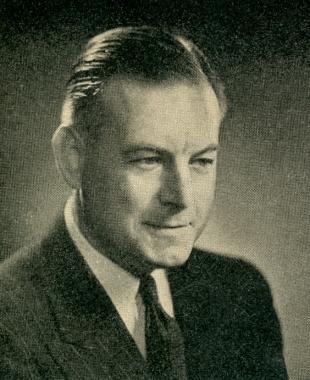
Gilbert Highet
Another reference to chess occurred on page 92 of Professor Highet’s book Man’s Unconquerable Mind (New York, 1954):
‘After Stalin had won his struggle for power against Trotsky, Trotsky’s work in building up the Red army was expunged from Communist history books and is now virtually forgotten inside the USSR. Such distortions are extended to quite small details. Thus, the most distinguished of modern chess masters was a Russian, Alekhine; since he repudiated the Bolshevik revolution, his name is not mentioned in Russian histories of chess.’
On page 134 Highet intimated that he had only a secondary source for that chess information: page 12 of British Chess by Kenneth Matthews (London, 1948). The matter seems to us far more complex. For example, page 34 of Soviet Chess by D.J. Richards (Oxford, 1965) noted that Russian editions of Alekhine’s games collections were published (e.g. in 1927 and 1932).
Do readers know of any extensive, authoritative overview of how Russian chess literature treated Alekhine after his departure from the Soviet Union?
From Leonard Skinner (Cowbridge, Wales):
‘I have looked again at my print of the Brooklyn Daily Eagle, and it seems that I misread Black’s 18th move. It should be 18...Q-R4 (Qh5). Because of the state of the microfilm in the Library of Congress my print was not as good as one might want, so I originally took the move to be 18...Q-B4, i.e. Qf5.’
Luca D’Ambrosio (Bolzano, Italy) has found various observations/predictions by Rudolf Spielmann in Sonntagsbeilage der Augsburger Postzeitung of 25 June 1927, page 104:

For a larger version, click here.
Two passages highlighted by our correspondent are given below, together with our translations:
‘Trotzdem Aljechin in New York teilweise glänzend spielte, würde es mich wundern, wenn er in dem im Herbst bevorstehenden Kampf um die Weltmeisterschaft gegen Capablanca auch nur eine Partie gewinnen würde.’ [Although Alekhine sometimes played brilliantly in New York, I should be surprised if, in this autumn’s world championship match against Capablanca, he were to win even a single game.]
‘Capablanca freilich hält mit seinen eisernen Nerven die fünfstündige Spielzeit glänzend durch. Schon wegen dieses Punktes allein glaube ich, daß Aljechin in seinem bevorstehenden Wettkampf keine ernstliche Chance hat.’ [Capablanca certainly maintains his iron nerve throughout the five hours of play. For that reason alone I believe that in his forthcoming match Alekhine has no serious chance.]
On page 238 of A Clerk of Oxenford (New York, 1954) Gilbert Highet commented that Paul Morphy ‘must have closely resembled Edgar Allan Poe and Charles Baudelaire, proud, taciturn, brilliant, self-doomed’.
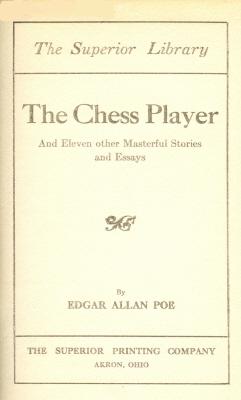
With regard to Edgar Allan Poe (1809-49), it may recalled that he had two main connections with chess, his lengthy article ‘Maelzel’s Chess Player’ and his negative remarks about chess in The Murders in the Rue Morgue. Below is a list of articles about Poe that we have noted in chess periodicals:
From Robert John McCrary (Columbia, SC, USA):
‘Pages 175-176 of the 1855 Chess Player’s Chronicle described a “chess match between the Manchester and Liverpool chess clubs” with nine players on each side. Manchester won 12-6, although the table is unclear; most participants apparently played two games, but two pairings seem to have involved three games. Two drawn games did not count, but those draws appear to have been made by contestants who played only two games. The Chronicle quoted as follows from the Manchester Examiner and Times of 21 April 1855:
“Wednesday [18 April] was certainly an unusual day in the annals of chess. Matches have frequently taken place between clubs by means of the post; but the present is almost the only instance of an exchange of visits between two clubs ...”Page 59 of the 1853 Chronicle had already suggested an over-the-board team-match:
“The representatives of two clubs might meet at some place convenient to both parties, and play a match of nine, 18 or 27 games, according to the number of delegates. But few days, indeed, could be spared for the necessary absence; yet everyone has some leisure occasionally, and far less time would be lost thus than in games by correspondence.
A challenge of the nature we suggest once emanated from the Liverpool Club, but was never accepted ...
The plan we suggest has been, we believe, very successfully tried in some of the Yorkshire clubs; and, indeed, it was but the same principle under another form which prompted the establishment of the Great Yorkshire Chess Association, which is every day receiving an accession of members from the Northern and Midland counties.”
Page 161 of the 1848 Chronicle (volume ix) had a letter dated 10 June 1848 from “Oxoniensis” saying that two players from the Trinity College, Cambridge Club had, in a “hasty visit” to Oxford, played two games against two of the best players of the Oxford Hermes Club, winning one and drawing one.
Finally, page xxiii of Löwenthal’s The Chess Congress of 1862 stated that at the 26 June 1855 meeting of the Northern and Midlands Counties’ Chess Association “matches between various clubs for prizes were played”. As these appear to have consisted of only a handful of games, and no players’ names were listed, it is unclear whether they qualify as “team matches”.’
On page 335 of his 1940s book Temas de ajedrez Manuel Golmayo paid tribute to Valentín Marín, affirming that a problem dedicated by Marín to Réti in Barcelona in 1927 was ‘the most beautiful and profound that I have seen in my long chess career’ (‘la más bella y profunda que haya visto en mi larga carrera ajedrecista’). A footnote added that the composition was given in part three of Golmayo’s book, leaving the reader to assume that it was this one, on page 385:
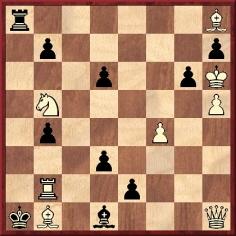
Mate in three.
However, when giving the solution to the problem (on page 398) Golmayo merely described it as one of Marín’s most beautiful compositions (‘una de las más bellas composiciones de nuestro genial compatriota’). Another discrepancy is that the problem, which won first prize in a Norwich Mercury ‘King in Corner’ tourney, pre-dates Réti’s emergence. It was published, for instance, on page 168 of the April 1905 BCM.
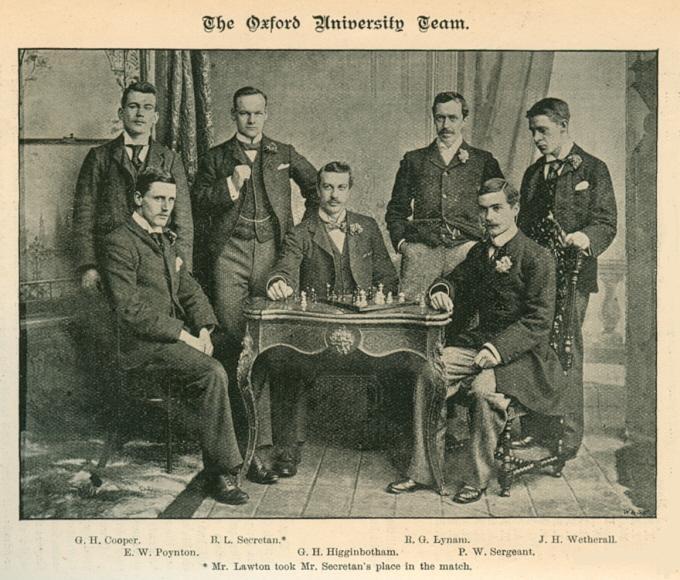
This photograph, featuring P.W. Sergeant, was published on page
228 of the April 1894 Chess Monthly. However, the
caption needs to be compared with what had appeared on page 236
of the magazine’s April 1893 issue:
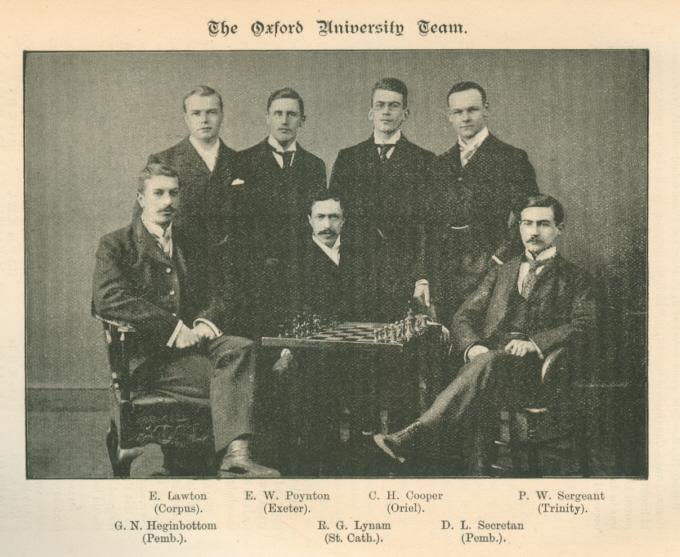
It will be noted that a mix-up occurred in identifying Sergeant and B.L./D.L. Secretan (or D.L./J.L. Secreton, according to pages 176-179 of the April 1893 BCM). For the picture of Sergeant from his book A Century of British Chess see page 118 of Chess Facts and Fables.
C.N. 1953 (see page 12 of Kings, Commoners and Knaves) gave the following position (Capablanca v N.N., simultaneous exhibition in Moscow, 1935) from the inside front cover of the 3/1935 issue of 64:
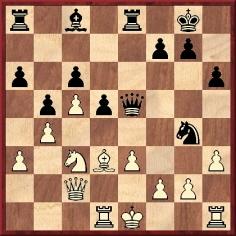
The Soviet magazine reported that play went 17...Qh5 18 Be2 Qh4 19 Bxg4 Bxg4 20 Rd4 Rxe3+ 21 Kf1 Re2 22 Nxe2 Bxe2+ 23 Kxe2 Qxd4, and Black won by continuing ...a5.
Now, Eduardo Bauzá Mercére (New York, NY, USA) offers a ‘tentative reconstruction’ of the preceding moves: 1 d4 d5 2 c4 e6 3 Nc3 Nf6 4 Bg5 Be7 5 e3 O-O 6 Nf3 Nbd7 7 Qc2 c6 8 Rd1 h6 9 Bh4 a6 10 a3 b5 11 c5 Re8 12 b4 Ng4 13 Bxe7 Qxe7 14 Bd3 e5 15 dxe5 Ndxe5 16 Nxe5 Qxe5 17 h3.
Mark N. Taylor (Mt Berry, GA, USA) draws attention to the dust-jacket of The Star of India by Carole Buggé (Gordonsville, 1998):
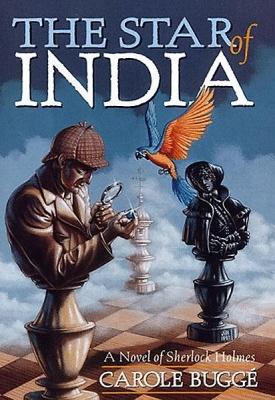

Mate in three.
From Josep Alió (Tarragona, Spain):
‘Manuel Golmayo’s book Temas de ajedrez (which is not even dated) has many mistakes. For example, the first page of text (page IX) has a position from a game between “Raulsen” (i.e. Paulsen) and Kolisch (played “en el ‘London Chess Club’ , de Bristol”) where the accompanying text states that Kolisch captured a “black”, instead of a “white”, pawn.
In the Marín problem, was the h5 pawn white or black? It was white according to the BCM, April 1905 (page 168) and La Stratégie, 19 June 1905 (page 193), but black in the Deutsche Schachzeitung, November 1905 (page 342). Moreover, it was black in three works by José Paluzíe:
- Manual de ajedrez, part five (“Problemas”), page 40 (Barcelona, 1912);
- Un artista en ajedrez (Valentín Marín), page 43 (Barcelona, 1913);
- Flores del ajedrez español, page 160 (Barcelona, 1924 – MS 946 in the Biblioteca Catalunya).
Paluzíe was a careful writer, a great problemist and a close friend of Marín. It is notable too that although Golmayo called the three-mover “the most beautiful and profound that I have seen in my long chess career”, Paluzíe made no special comment on it in his books.’
We note that the colour of the pawn makes no practical difference, but that such a unit is required, to prevent (after the key move 1 Qc6) 1...e1(Q) 2 Qc1 Qh4+.
Bradley J. Willis (Sherwood Park, Alberta, Canada) submits an
addition to our list of Reinfeld’s
Non-Chess Books: an abridgement (New York, 1949) of Gilbert
Cannan’s translation of the novel Jean-Christophe by
Romain Rolland.
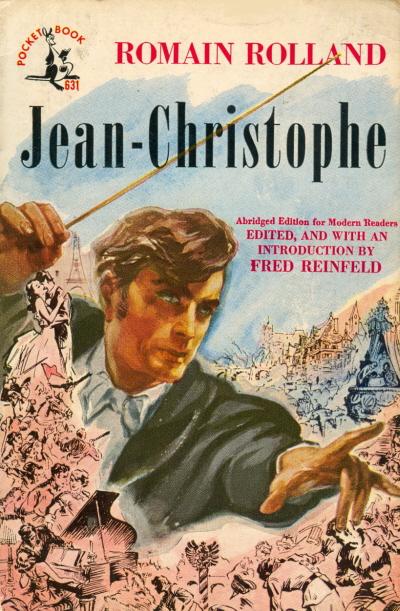
Our correspondent quotes a remark by Reinfeld in his ten-page introduction (on page xvi):
‘Rolland’s masterpiece is perhaps the last work of its kind, written in an age when a man could devote a decade or two to the preparation of one book. Today there is history in every headline, and everything dates with frightening rapidity.’
Reinfeld also produced an abridgement of Oliver Twist (see C.N. 4859).
Page 3 of Chess Lyrics by Alain C. White (New York, 1905) quoted from A.F. Mackenzie’s memoir of Steinitz in the Jamaica Gleaner, 1900:
‘One interesting trait in Steinitz’s chess character was his warm admiration for and strong advocacy of problems, the “Poetry of Chess”. He was no composer himself, but a very expert solver; and on one occasion signalized his interest in the art by taking part in a problem solution tournament. This fact is worthy of passing notice, because there are those who affect “to see no good” in problems, and depreciate their study on the hypothesis that it has a prejudicial effect on the power for play over the board. This is a most mistaken notion; for the very contrary is the fact, and the study of problems is bound to improve one’s practical play. It will be generally found, however, and it is a rather curious coincidence, that those who preach that fallacious doctrine know nothing whatever of problems. They have never journeyed through the fairyland of problem lore; nor, indeed, have they the capacity to understand or appreciate its delights. They are, in fact, so many chessical gradgrinds. With souls that cannot soar into the infinite of chess, they are dead to the spirit of its poésie. The homely aphorism “you cannot make a silken purse out of a sow’s ear” aptly fits their case; and when he who held the sceptre of the chess world for over a quarter of a century paid such high tribute to the charm and worth of problems, the apostles of that other faith may well be allowed to revel in the luxury of their own benighted belief.’
The happy term ‘chessical gradgrinds’ takes a place in our Chessy Words list. It antecedes the entry ‘… we are much mistaken if affairs chessical do not enjoy a notable enlivenment so long as he remains in our midst’ (W.E. Napier writing about Eisenberg in the Pittsburgh Dispatch, 4 August 1904).
Page 14 of Chess World, 1 January 1947 quoted from an article by Botvinnik in Ogonyok which was subsequently published in Albrecht Buschke’s periodical Chess News from Russia. An extract is given below:
‘During the Nottingham tournament of 1936 I happened to watch a curious scene. Bogoljubow was sitting deeply bent over the board, and was thinking tensely. Alekhine was briskly wandering around the table, fixedly looking at his opponent. Willy-nilly, I became interested, drew near to the table and saw the position after Alekhine had made his 35th move P-N5 [g5].
What can Black do? He has an extra pawn, but the situation is tense and the material superiority does not tell. White threatens 36 PxP, after which his bishop would be very strong.
Bogoljubow played 35...PxP. He had not taken the pawn off the board when Alekhine hurriedly approached and, without sitting down, played 36 P-B5!!, noisily banging down the piece. This sacrifice was so unexpected that Bogoljubow literally jumped out of his chair, in spite of his solid constitution. Evidently he had figured only on 36 PxPch K-N1; and in view of the threat, ...P-K4, Black’s situation would be quite secure.’
Alekhine’s annotations to the game can be found in the Nottingham, 1936 tournament book and in his second volume of Best Games.
C.N. 2424 (see page 392 of A Chess Omnibus) mentioned that the famous maxim ‘Nothing is harder than to win a won game’ has been attributed to various writers and that it appeared on page 9 of Schach-Aphorismen und Reminiscenzen by A. Albin (Hanover, 1899): ‘Nichts ist schwerer als eine gewonnene Partie – zu gewinnen’.
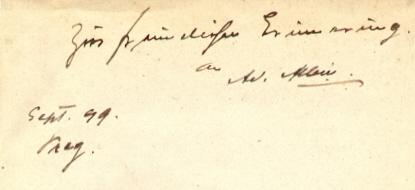
Inscription by Albin in our copy of Schach-Aphorismen und Reminiscenzen
Now we note the following on page 293 of the Chess Player’s Chronicle, 13 December 1890:
‘This game is a further illustration that, as Steinitz says, “the most difficult part of chess is to win a won game”.’
Can other early instances of the remark be found, in the writings of Steinitz or anyone else?
Wanted: specimens of the anti-Turton theme in over-the-board play. Only two instances have been given in C.N. so far (see C.N.s 553 and 681, on pages 5-6 of Chess Explorations). The first occurred in the game Edward Lasker v Marshall, New York, 1924.
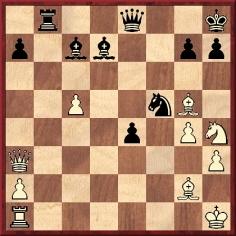
White played 28 Bf4 (preventing ...Qe5).
Wolfgang Heidenfeld’s explanation of the anti-Turton theme, using the above example, was quoted in C.N. 553 from pages 10-11 of his book Lacking the Master Touch (Cape Town, 1970):
‘It consists in forcing the attacker who wishes to double two pieces on the same gait in such a way as to have the stronger piece in front and the weaker behind (called the Turton in the jargon of problemists) into playing the weaker piece across the so-called “critical square” (here Black’s K4) and thus into reversing the planned line-up ...’
The second position was provided in C.N. 681 by our correspondent Michael McDowell (Westcliff-on-sea, England) from page 124 of Modern Chess Tactics by L. Pachman (London, 1970):
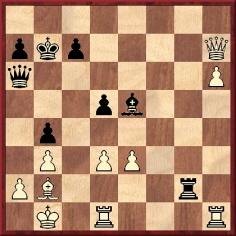
Lucarelli v Carra, Bologna, 1932. If 1 d4 then 1...Qe2. White therefore played 1 Rd2 Rxd2 2 d4 Qe2 3 Bc1, and Black resigned.
Is the full game-score available?

White to move and win.
This position (V. Tietz v A. Schwalb, Carlsbad, 5 March 1904) was given on pages 194-195 of the May-June 1905 Wiener Schachzeitung, which stated that White won with ‘eine gigantische Kombination’: 1 Ng6+ fxg6 2 fxg6+ Kg8 3 Rc8 (The magazine lavished three exclamation marks on this.) 3...Rxc8 4 Rxc2 Rf8 5 Rc8 Qe7 6 Qc4+ Kh8 7 Qh4 Ra1+ 8 Bxa1 Qe3+ 9 Kh1 Rxc8 10 Qxh5+, and White had a forced mate.
This brilliancy was first mentioned in C.N. in 1982 (C.N. 215), with reference to an article entitled ‘Victor Who?’ by R.C. O’Neale on pages 150-152 of the August 1981 CHESS. It was one of five Tietz positions given by O’Neale, although with a black knight, not bishop, on c2 and dated 1898 rather than 1904. The other four were:
C.N. 215 also noted the following passage on page 380 of the
October 1905 BCM (courtesy of the Australasian):
‘Herr Tietz has long been famous for the depth and subtlety of his chess combinations. The Wiener Schachzeitung says that “it is fortunate for him that the days of the Holy Inquisition are gone by. The demoniacal brilliancy of his ideas would certainly have exposed him to the suspicion of having made a bargain with His Highness the Prince of Darkness”.’
The Wiener Schachzeitung and the BCM/Australasian presented a second position against Schwalb, in which Tietz had the black pieces (Carlsbad, 24 September 1904).
In C.N. 516 we gave a further combination (Roland v Tietz,
Carlsbad, January 1902) from page 102 of the May-June 1902 Wiener
Schachzeitung. The same page had a full game-score (Tietz v
R. Welsch, Carlsbad, 18 July 1901). Many other Tietz games and
positions are to be found in old magazines, and below is a
non-exhaustive list:
Brüderschaft, 15 January 1887, page 22:
- C. Lambers v Tietz, Pörtschach, August 1885
- Tietz v A. Bayer, Cracow, 2 January 1886
Brüderschaft, 5 February 1887, pages 49-50:
- Tietz v Eyller, Vienna, 1881 (complete game)
Brüderschaft, 5 May 1888, pages 140-142:
- J. Holzwarth v Tietz, Vienna, 27 February 1887 (complete game)
- Tietz v F. Melzer, Vienna, 9 February 1888 (complete game)
Deutsche Schachzeitung, October 1888, page 310:
- Tietz v H. (knight’s odds), Vienna, 1 September 1888
Chess Amateur, January 1927, pages 100-101 gave six positions from Der Schachkongress zu Braunau (Leipzig, 1926):
- A. Schwala [sic] v Tietz, Carlsbad, 25 January 1914
- Tietz v A. Bayer, Krakad [sic], 2 January 1886
- Tietz v Moritz Porges ‘played 10 November in the Prage [sic] Chess Club’
- Tietz v W. Mader ‘played 10 November in the Prague won’ [sic]
- Roland v Tietz, Carlsbad, January 1902
- A. Russ v Tietz, Carlsbad, June 1903.
The Chess Amateur then published, on pages 101-102, victories (complete games) by Tietz over Chigorin, Schlechter and Lasker in 1904, 1906 and 1915 respectively.
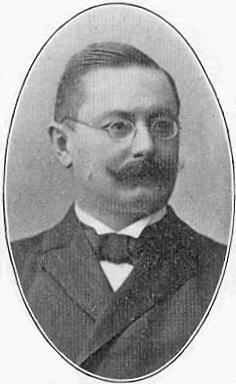
Victor Tietz
We should be particularly interested in tracing any contemporary claims that Tietz’s brilliancies were not to be taken at face value, and one such instance can be mentioned here: an article entitled ‘A Brilliancy that never happened’ on pages 26-27 of Lasker’s Chess Magazine, November 1907. It discussed the position below, supposedly from a queen’s rook odds game in Carlsbad:
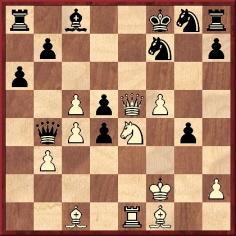
White (Tietz, in play against an unnamed amateur) was said by ‘a valued contemporary’ to have won with 1 Qe8+ Kxe8 2 Nf6+ Kd8 3 Re8+ Kc7 4 Bf4+ Kc6 5 Rxc8+ Rxc8 6 cxd5+ Kxc5 7 Nd7+ Kxd5 8 Bg2 mate. Without making any direct accusation against Tietz (indeed, he was depicted as a victim), Lasker’s Chess Magazine set out at length its reasons (e.g. which moves could have led up to the diagram?) for believing that ‘the position could not possibly have arisen in actual play, except after a feast wherein the drinks were not restricted to buttermilk’.
With the permission of Mr David DeLucia we reproduce the following from page 265 of his new volume (see C.N. 5323):
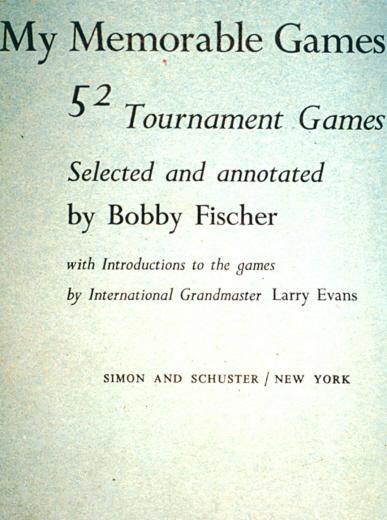
Dated 1967, this comes from ‘a rare “review copy” of a book
that was never published which was in Bobby Fischer’s personal
library’. Mr DeLucia also remarks that two years later My 60
Memorable Games was published, ‘the first 52 being the
same as the review copy’.
From Thomas Bohn (Koblenz, Germany):
‘For some years I have been researching the history of chess in the Rhineland (“Geschichte des Schachspiels im Rheinland 1800-2000”) – see www.svkoblenz.de – and I should be grateful to know if any collector owns the very rare Mittelrheinischer Schachkalender 1/1934 and 2/1935/36.
I am also seeking the personal dates of a) Adalbert Wachhausen, a chemist who founded the Koblenz Chess Club in 1878 but left the city in 1883, and b) Nathan Mannheimer of Frankfurt (born around 1865?). Did he die in the Holocaust?’
Charles Sullivan (Davis, CA, USA) raises the subject of Alekhine v Nowarra, Cracow, 17 October 1941, as given on page 670 of Alexander Alekhine’s Chess Games, 1902-1946 by Leonard M. Skinner and Robert G.P. Verhoeven (Jefferson, 1998).
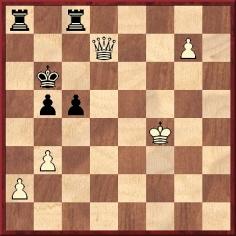
Our correspondent asks whether, after 52 Qe6+ Rc6, Alekhine really overlooked 53 g8(Q), which wins at once.
The book’s source was pages 172-173 of the November 1941 Deutsche Schachzeitung:
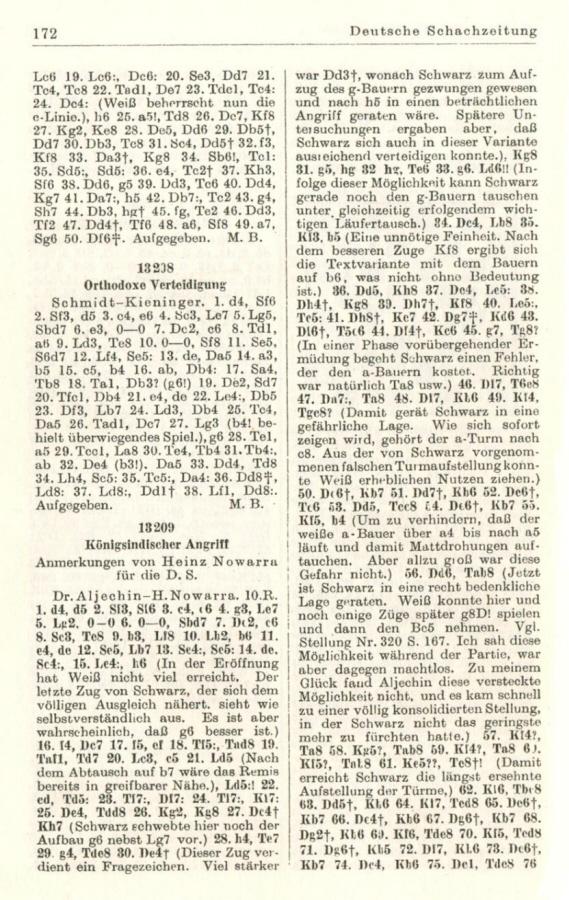

It will be seen that Heinz Nowarra provided notes, and that the game-score corresponds to what appeared in the Skinner/Verhoeven book. However, a correction to the score was published on page 181 of the December 1941 magazine, where ‘M.B.’ (Max Blümich) indicated that White’s 52nd move was Qd6+, not Qe6+:

We have few biographical details on hand concerning Heinz Nowarra. A small photograph of him was given on page 158 of the December 1942 Deutsche Schachzeitung, with the information that he was born in 1897.
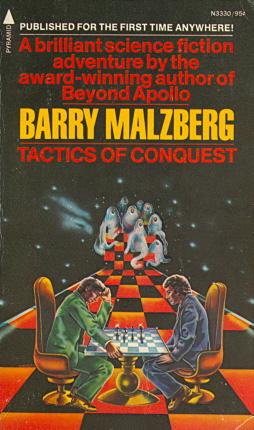
Evidently written in the immediate aftermath of the Spassky-Fischer world championship match, Tactics of Conquest by Barry Malzberg (New York, 1973-74) is, according to the front cover, a ‘brilliant’ novel by an ‘award-winning author’. The first page of text reads:
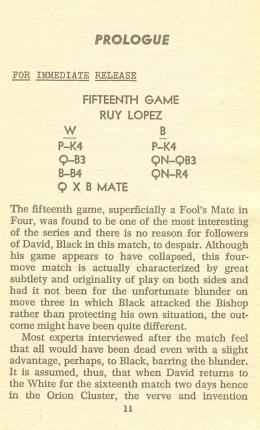
Two pages later the award-winning author gives a prose account of this gamelet, which somehow culminated in a bishop being captured:
‘White’s opening move P-K4 is a conventional Ruy Lopez but Black’s responding P-K4 indicates that he is in a “fighting mood” and ready to “join the battle”. White’s second move, an over-ambitious posting of the queen, indicates an open game; Black’s response, a quick development of the knight, shows that he is following for the moment convenient lines of Ruy Lopez still.
It is at White’s third move, B-B4, that the match becomes truly original, making its first contribution to the literature on outstanding contests. It is an obvious attempt to play a fighting game in the center of the board: The temporary abandonment of the queen further reveals the true openness of the contest. Black’s response, attacking the queen, is a rugged joining of the battle. Deviating from the Ruy Lopez on the third move and its conventional Sicilian, Black has shown himself willing to move into truly uncharted waters. One can only admire and be awed by the depth and profundity of this move.
White’s sudden capture of the black bishop, forcing mate, is, of course, unfortunate in that it could be said to bring the game to a swift conclusion, although grudging credit must be given for its ingenuity ...’
Mr Malzberg’s ineffable approach to describing chess play is further shown on page 51:
‘He began with a King’s Pawn attack; I countered at the sides, bringing out the king knight and castling early in a variation of the Nimzo-Indian; a Queen’s Gambit he offered was declined ...’
And, again, on page 149:
‘He could not take the bishop because it would leave a hanging pawn ... and if I were then to take the open rook behind the bishop, I would have a devastating discovered check. The bishop could go queen-side, it could go down the line to double-check, it could pause to go on nibbling on a rook. And nothing to be done. The double-knight maneuver pinned him.’
To avoid the narrative flow being clogged up, or bogged down, with explanations of technicalities, the book concludes with a seven-page glossary of chess terms, such as the following (from page 166):
‘Ruy Lopez: ... This attack involves a penetration of the center by the king and queen’s pawns with the subsequent rapid opening of the bishop file, from which squares the knights may control the center. Direct and powerful attack meant to march down the board; it is easily defeated by a Sicilian defense in which the advance of the pieces is blocked. Now in partial disfavor, the Ruy Lopez has been displaced by the modernists. It is still often seen in amateur games. The Ruy Lopez is capable of producing a Fool’s Mate against an inexperienced or nervous player who might fail to note positioning of the queen and king’s bishop.’
The same page affirms:
‘Sicilian defense: A common refutation of the Ruy Lopez, employed by many experts and well within the technical facilities of all grandmasters.’
Page 165 says that the rook is ‘considered to be half as powerful as the king’.
The novel itself features much indiscriminate name-dropping, in the tradition of general chess writing. A specimen from page 147:
‘Indeed it has a long and honorable history, this discovered attack. Most notably it was used by the long-deceased Frank Marshall in his famous “shower of gold” game against a then world champion in New York City at the turn of the century. Unfortunately it was not in a tournament game.’
Seldom are names dropped accurately. From page 33:
‘I motioned to the omnipresent pocket chess set, at this time poised in midst of a replay of the Immortal Game, the Andersson queen having penetrated to the seventh rank for that masterful sacrifice.’
Andersson, of course, should not be confused with Anderssen, or Immortal with Evergreen. Or Anderssen with Steinitz, given what appears on page 72:
‘Adolf Andersson, author of the Immortal Game, challenged God publicly, in his last years, to a game of chess. “I’ll give him pawn and move”, said Andersson.’
One final sample passage comes from the previous page:
‘Later in his life Steinmetz, the first official (as opposed to merely “recognized”) world champion, begged to meet Morphy who finally agreed only on condition that the meeting was for ten minutes and chess was not discussed. Morphy eventually died of tuberculosis. Annals do not reveal if he and Steinmetz ever met.’
There has never been a chess novel quite like Tactics of Conquest. For writing about the royal game with such uninhibited indifference to the concerns of grouchy purists, the award-winning Mr Barry Malzberg could surely be granted, with ease, one further accolade, however belatedly: a chess award.
Awani Kumar (Kanpur, India) writes:
‘I have compiled over 1,300 single diagonal magic knight’s tours on a 12x12 board and 76 magic knight’s tours on a 16x16 board, as well as 54 magic knight’s tours in a 4x4x4 cube. In addition, I have constructed a magic knight’s tour in a 12x12x12 cube, which is, to date, the largest magic tour of a knight in a cube. The details are available at this webpage. I have also constructed an open knight’s magic tour on the surface of an 8x8x8 cube, as in the illustration.’

Chess has been called many things but, to our knowledge, only Harry Golombek has ever labelled it scribogenic. The neologism appeared in his column on page 10 of The Times of 1 October 1977:
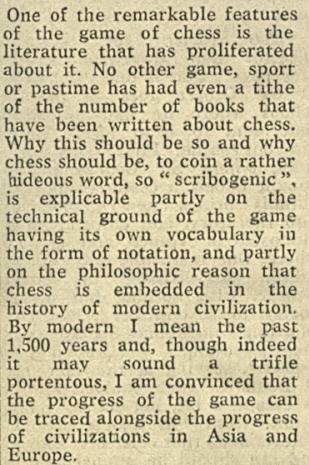
Robert John McCrary (Columbia, SC, USA) adds to the information he provided in C.N. 5340:
‘Page 281 of the Chess Player’s Chronicle 1845 (volume 5) reported on a speech by W. Robinson at the Nottingham chess meeting of players of the Northern and Midlands counties regarding efforts to revive chess interest:
Pages 280-281 also had references to the importance of the railway in making such meetings possible.’“The consequence was that several matches were made between players from the different towns in Yorkshire, who, although not the best players, were considered pretty equal in proficiency. Of course, these matches could not be played in one day; and the consequence of the visits of the players of one town to the players of another was a general meeting. The first assembly of this description took place in 1840, and a great impetus being thus given to the progress of chess, he was happy to say these annual gatherings had been kept up ever since.”
We are grateful to Jan Kalendovský (Brno, Czech Republic) for a PGN file of games and positions involving Tietz (totalling 21 and 23 respectively).
Alan McGowan (Waterloo, Canada) mentions that the website of the Berliner Schachverband gives Heinz Nowarra’s year of birth as 1910 and also features him in a group photograph.
Concerning the game Capablanca v Bogoljubow, Moscow, 1925, Charles Sullivan (Davis, CA, USA) comments that such annotators as Bogoljubow, Reinfeld and Kasparov indicated that 17 Qf7 was inferior to the move played by Capablanca (17 Qxb6), owing to 17...Rf8.

However, our correspondent suggests that 17 Qf7 may be objectively preferable, because after 17...Rf8 the previously-neglected move 18 Qe7 apparently leads to a position which Black cannot win.
Page 109 of the 1 May 1947 Chess World reported:
‘The Adelaide player F. Villner claims a world’s record: shortest game ever won by a player receiving odds in a tournament. The game was played in a lightning tourney in Sweden, the time-limit being three seconds a move.’
Black, who played without his f-pawn, was not named. The moves were 1 d4 Nc6 2 e4 Nh6 (‘Aiming at f7, a recognized development at these odds, but not after White has played d4.’) 3 Bxh6 gxh6 4 Qh5 mate.

From Mark N. Taylor (Mt Berry, GA, USA):
‘In my forthcoming bibliography (mentioned in C.N. 3616) I describe Barry Malzberg’s Tactics of Conquest as an “anti-chess” novel. The historical inaccuracies (or, at least, most of them) and puerile descriptions of chess moves are quite deliberate. The novel, however, betrays only rare instances of self-awareness of the absurdities:
“There is a very definite scholarly point of view, of which I am the sole proponent, which holds that the game was invented in Peru somewhere in the middle of the sixteenth-century and that all of the ensuing political struggles of the world can only be seen as a series of stumbling, halting efforts to get back to its purest inceptions and outlines.” (Page 108)
“It is possible that certain aspects of this memoir are fabricated, but not all of them are.” (Page 157)
All of the games are poorly played and poorly explained because they are played by adolescent boys of no special talent, and not by 50-year old grandmasters as we are first given to believe. The narrator is one of the boys, a Fischeresque character, but lacking Fischer’s pleasantness and sanity. The hype surrounding their match for “the fate of the universe” is a product of the narrator’s imagination, probably influenced by the hype of the Spassky-Fischer match (as you inferred in C.N. 5355). The reason why the narrator detests his opponent so rabidly and why the match signals in his mind the final struggle of good against evil is not revealed until the Epilogue, a piece of nastiness which I shall not repeat here.
That said, not everything in the novel is humbug, and Malzberg can sometimes be thoughtful. For example:
“Chess too is an artifact, a set of ruins in which, however distantly, may be perceived the intricate and terrible outlines of a long-perished civilization. All of us, grandmasters and patzers alike, in our obsessive quest across the board, our attempts to find the proper combinations and patterns which will lead to some understanding of the game (the game has never been truly understood, even by Fischer, even by Alekhine) are merely stumbling to unearth some gleaming and true artifact which will bring us the message fully and unlock the way to the secret, hidden treasure.” (Page 107)
I regard this “anti-chess” novel most charitably as an experiment, and a not very successful one. In my opinion, being deliberately bad disqualifies it for any sort of anti-award.’
Wanted: information about Hermann Keidanz (Keidanski). In particular, we wonder whether readers can add to his entry in Jeremy Gaige’s Chess Personalia (Jefferson, 1987):
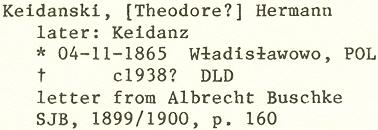
This photograph of Keidanz appeared on page 126 of the May 1910 American Chess Bulletin:

The problem below, a joint production by Keidanz and Emanuel Lasker, was given in C.N. 1719:

Mate in four.
The composition was published on page 214 of the October 1906 American Chess Bulletin, with the solution presented on pages 17-20 of the January 1907 number. It was the subject of a prize competition, and the winner, who solved it in 25 minutes, was Murray Marble (1885-1919).
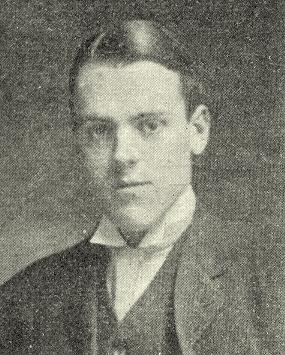
| First column | << previous | Archives [41] | next >> | Current column |
Copyright: Edward Winter. All rights reserved.